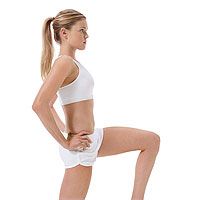Here are the strengths, weaknesses, and everything in between, teen runners should know about so they can maximize their running ability.

Ah, youth. Without even trying, you’re gaining speed and recovering instantly. Your body is catapulting into adulthood, and everything from muscle mass, strength, bone density, and VO2 max (the volume of oxygen your body takes in and processes) are on the rise. “A weakness?” says Jeremy Acosta, a 17-year-old cross-country star from Palmdale, California, who lists hills and his final kick as his fortes. “Um, maybe the middle mile of the race?” Yet even a young career can encounter roadblocks. As a freshman, Acosta suffered from Osgood-Schlatter, a common condition that strikes athletes during growth spurts. It causes tenderness just below the knee, and resolves itself once development slows. Acosta ran through it, and when it subsided, he grew into one of his region’s top runners.
1. Your Strengths
Runners in the throes of puberty have superpowers–literally. A British study compared 12 boys and 13 men doing 10 sets of 10-second sprints. The boys sustained their power output better than the men, partly because teens regenerate creatine (a compound that supplies muscles with energy) more quickly than older runners. Also, levels of lactate, the by-product that accompanies intense efforts, are naturally lower in teens. Girls share the same ability to pour on the power–and can sustain it even better than boys. Japanese researchers found that in a series of sprints, teenage girls lost 10 percent less power than boys their age did. That said, as muscle mass piles on, boys have a distinct upper hand–or, in this case, quad. “Boys develop proportionally more muscles than girls do and get the natural power advantage,” says Cameron Blimkie, Ph.D., professor of kinesiology at McMaster University in Ontario.
As they develop, running–or other weight-bearing exercise–helps make bones as dense as possible. Blimkie coauthored studies that looked at the bones of female runners, triathletes, cyclists, and swimmers. Runners had the highest bone-mineral density and strength of the four groups.
2. Your Weaknesses
As fit as you are, your growing body still needs to be handled with care. Bones develop faster than their supporting ligaments and tendons. As a result, joints and muscles can be prone to injury.
Many young female runners who repeatedly miss their periods develop a condition called amenorrhea, says Anne Hoch, D.O., director of the Women’s Sports Medicine Program at the Froedtert & the Medical College of Wisconsin. One study determined that 30 to 41 percent of 422 high school- and college-aged female runners had the disorder. Amenorrhea is a red flag for all female runners but is especially troubling for teens in the midst of their bone-building years. (Menstruation releases estrogen, which is vital for calcium absorption.)
Experts advise both girls and boys to not take on too much mileage too soon, though there isn’t a con–sensus on what exactly “too much” is. Each year, a group of middle school and high school students runs the Los Angeles Marathon with a 90 percent finishing rate and very few medical problems on race day, according to Rudra Sabaratnam, M.D., medical commissioner of the race. Other experts think the marathon is worth waiting for. Lyle Micheli, M.D., director of sports medicine at Children’s Hospital Boston, prefers a conservative approach: an upper limit of three miles, five days a week for kids younger than 14, and six miles most days a week for kids 14 to 18.
3. Exercise Rx
Work on building your form and your endurance so you can become a balanced, injury-free runner down the road. Practice sprint-specific drills, like high knees and skips, to build a strong foundation and fast turnover, ideally under a coach’s supervision. “If we can get an athlete to have good form during the early years, that helps so much with both performance and injury prevention in later years,” says coach Greg McMillan, owner of McMillan Running in Flagstaff, Arizona. Boost aerobic capacity by increasing long runs by five minutes weekly. Go by minutes, not miles, and when in doubt, take it slow. “Not every training run should end with your hands on your knees,” McMillan says.
4. Nutrition Rx
Got milk? You’d better–and yogurt, cheese, and other calcium-rich foods. To maximize your bone-building potential, the National Institutes of Health recommends 1,300 milligrams (mg) of calcium daily (eight ounces of milk has about 300 mg) for boys and girls up to age 18, when the recommendation drops to 1,000 mg until age 50. Girls with amenorrhea may need as much as 1,500 mg a day, Hoch says.
Source: runnersworld.com